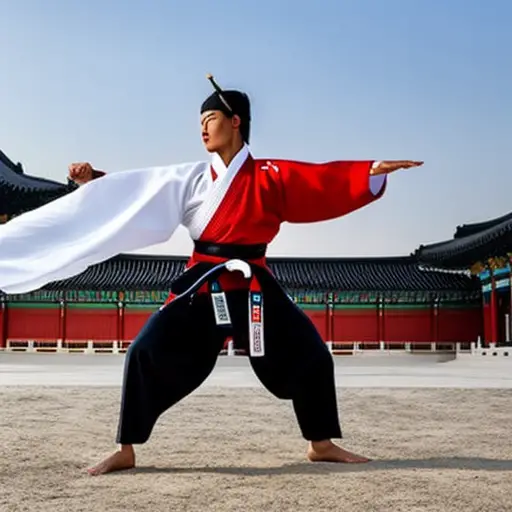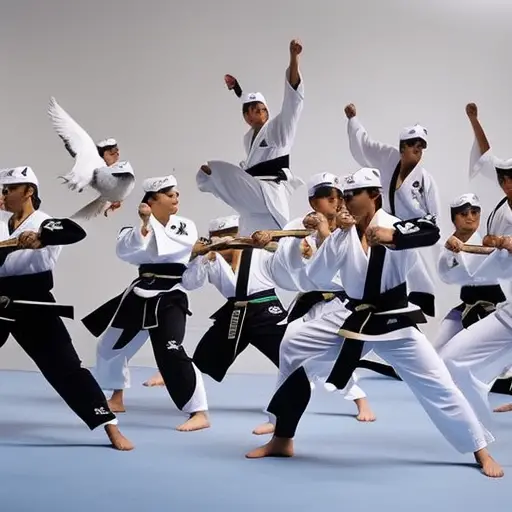The Role of Taekwondo in South Korean Culture

Coinciding with its deep-rooted historical origins and national significance, Taekwondo has emerged as a vital component of South Korean culture. This traditional martial art not only embodies the nation’s rich heritage but also serves as a symbol of national pride and identity.
Moreover, Taekwondo’s integration into the South Korean education system underscores its fundamental role in developing physical and mental discipline among individuals.
As we delve into the multifaceted influence of Taekwondo on South Korean society, a comprehensive understanding of its role in shaping the country’s cultural fabric is revealed.
Historical Roots of Taekwondo in South Korea
One of the most significant aspects of understanding the role of Taekwondo in South Korean culture is to delve into the three historical roots that have shaped its development. These roots include the ancient Korean martial arts, the influence of Japanese occupation, and the post-war reconstruction period.
Taekwondo has deep cultural significance in South Korea, as it embodies the values and philosophies that are inherent to the Korean people. The philosophy of Taekwondo revolves around the tenets of respect, discipline, perseverance, and self-control. These principles are not only applied within the realm of martial arts but also in everyday life, making Taekwondo an integral part of the Korean cultural fabric.
The ancient Korean martial arts, known as Subak and Taekkyeon, laid the foundation for the development of Taekwondo. These practices were influenced by the military training techniques used during the Three Kingdoms period and were later refined and systematized.
The Japanese occupation of Korea from 1910 to 1945 also played a significant role in the development of Taekwondo. During this time, the Japanese government restricted the practice of traditional Korean martial arts and implemented their own martial arts disciplines. However, this period also sparked a sense of national pride and resistance, leading to the preservation and resurgence of Korean martial arts, including Taekwondo.
The post-war reconstruction period in South Korea further solidified the cultural significance of Taekwondo. The Korean government, recognizing the potential of Taekwondo as a symbol of national identity, actively promoted its practice and development. Taekwondo schools were established across the country, and efforts were made to standardize the techniques and curriculum.
Taekwondo as a Symbol of National Pride
The significance of Taekwondo as a symbol of national pride in South Korea cannot be overstated. This martial art form has become deeply ingrained in the country’s national identity, representing the values, traditions, and history of the Korean people. Taekwondo’s popularity and influence extend far beyond the realm of sports, making it an integral part of South Korean culture.
Here are four reasons why Taekwondo holds such importance as a symbol of national pride:
-
Historical significance: Taekwondo traces its roots back to ancient Korean martial arts, reflecting the rich history and heritage of the Korean people. Its development over the centuries is a testament to the resilience and spirit of the nation.
-
Cultural preservation: Taekwondo serves as a guardian of Korean traditions and values, promoting discipline, respect, and self-control. By practicing and promoting Taekwondo, South Koreans preserve their cultural heritage and pass it on to future generations.
-
International recognition: Taekwondo’s inclusion as an official Olympic sport in 2000 further solidified its status as a symbol of national pride. The sport’s global recognition allows South Korea to showcase its excellence and prowess on the international stage.
-
Unifying force: Taekwondo has the power to bring people together. Through training and competition, individuals from different backgrounds can come together to celebrate the shared values and national identity that Taekwondo represents.
Taekwondo as a Core Component of South Korean Education
Taekwondo plays a significant role as an essential component of South Korean education, shaping the physical, mental, and moral development of students throughout the country. In South Korea, physical fitness is highly valued, and taekwondo provides an effective means of promoting physical health and well-being among students. Through rigorous training and practice, students not only develop strength, flexibility, and endurance but also improve their overall coordination and body control.
In addition to physical fitness, taekwondo instills discipline and respect in students. The strict training regime and adherence to the tenets of taekwondo, such as courtesy, integrity, perseverance, self-control, and indomitable spirit, foster discipline and self-motivation. Students learn to follow instructions, maintain focus, and push themselves to achieve their goals. Moreover, taekwondo emphasizes respect for oneself, instructors, fellow practitioners, and the art itself. Students are taught to bow before entering and leaving the training hall, showing respect to the space and the people within it.
The values of discipline and respect learned through taekwondo training extend beyond the training hall and into other aspects of students’ lives. They learn to be respectful and considerate towards others, developing positive character traits that contribute to a harmonious society. Taekwondo as a core component of South Korean education thus serves as a means to shape well-rounded individuals who possess physical fitness, discipline, and respect.
The Physical and Mental Benefits of Taekwondo Practice
As students engage in regular taekwondo practice, they can experience a multitude of physical and mental benefits due to the rigorous training and discipline involved. Taekwondo is not only a martial art but also a form of physical fitness that promotes overall well-being.
Here are four key benefits of taekwondo practice:
-
Improved Physical Fitness: Taekwondo training involves various exercises and movements that enhance cardiovascular endurance, strength, flexibility, and agility. The high-intensity nature of the practice helps students burn calories and build lean muscle, leading to improved physical fitness.
-
Discipline: Taekwondo instills discipline in practitioners through adherence to strict training routines and protocols. The practice requires dedication, self-control, and perseverance, helping students develop discipline not only in the dojang (training hall) but also in other areas of their lives.
-
Mental Focus: Taekwondo emphasizes mental focus and concentration. Practitioners learn to clear their minds, block out distractions, and maintain focus during training and competitions. This mental discipline translates into improved concentration and focus in other aspects of life as well.
-
Stress Relief: Engaging in taekwondo practice can provide an excellent outlet for stress relief. The physical exertion and concentration required during training help release tension and promote mental well-being.
Taekwondo’s Influence on South Korean Society and Identity
Throughout decades of practice and dedication, taekwondo has ingrained itself into the fabric of South Korean society, shaping the country’s identity and fostering a sense of national pride. One significant aspect of taekwondo’s influence on South Korean society is its impact on gender equality. Historically, martial arts were primarily seen as a male domain, but taekwondo has challenged this notion by actively encouraging the participation of women. By providing equal opportunities for both men and women to train and compete, taekwondo has helped to break down gender barriers and promote gender equality in South Korean society.
Furthermore, taekwondo plays a crucial role in South Korea’s international diplomacy efforts. The sport has become a powerful tool for promoting cultural exchange and building diplomatic relations with other nations. Through international tournaments, demonstrations, and cultural exchanges, taekwondo showcases South Korean culture and values, such as discipline, respect, and perseverance. This not only enhances South Korea’s global image but also fosters a sense of national pride among its citizens.
Additionally, taekwondo’s inclusion in major international sporting events, such as the Olympic Games, further solidifies its role in international diplomacy. As a widely recognized and respected sport, taekwondo provides a platform for South Korea to engage with the international community, strengthen diplomatic ties, and promote peace and understanding among nations.
Frequently Asked Questions
How Many Different Styles of Taekwondo Are Practiced in South Korea?
There are numerous different styles of taekwondo practiced in South Korea, each with its own unique characteristics and techniques. The influence of taekwondo on South Korean society is significant, as it is deeply ingrained in the cultural fabric of the country.
What Are Some Famous Taekwondo Practitioners From South Korea?
Some famous taekwondo practitioners from South Korea include Choi Hong-hi, Kim Soo, and Hwang Kee. Taekwondo has had a significant impact on the mental health of South Korean athletes, enhancing discipline and resilience.
Has Taekwondo Always Been Considered a National Sport in South Korea?
Taekwondo has not always been considered a national sport in South Korea. However, it has played a significant role in the country’s military, with its emphasis on discipline and physical fitness. Moreover, taekwondo has had a positive impact on the South Korean economy through its global popularity and the establishment of training centers worldwide.
Are There Any Cultural Events or Festivals in South Korea That Celebrate Taekwondo?
Cultural events and festivals in South Korea that celebrate Taekwondo play a significant role in highlighting its cultural significance and promoting international recognition. These events showcase the artistry, skill, and values associated with this martial art.
How Has the Popularity of Taekwondo in South Korea Changed Over the Years?
The popularity of taekwondo in South Korea has undergone significant changes over the years. It has had a profound impact on South Korean society, influencing various aspects such as sports, fitness, self-defense, and national pride.
Conclusion
In conclusion, Taekwondo holds a significant role in South Korean culture, both historically and in contemporary society.
It serves as a symbol of national pride, a core component of education, and offers numerous physical and mental benefits to practitioners.
The influence of Taekwondo on South Korean society and identity is undeniable, as it fosters discipline, resilience, and a sense of community.
This martial art has become deeply ingrained in the fabric of South Korean culture, embodying the values and traditions of the nation.




